For Duke, UNC football, sustained success remains elusive — and is more important than ever
- Oops!Something went wrong.Please try again later.
The first time Duke and North Carolina met as ranked teams in football came with memorable anticipation and the kind of media coverage that, for its day, reflected the stakes and cultural significance of the event. It was met with “Game of the Century” type hype, and was viewed then as a harbinger of what could be expected in football at both schools.
Upon another Duke-UNC football game on Saturday, the 109th since their first game, in 1888, it’s worth looking back at the past, both recent and much more distant. Because the answer is in there, somewhere, to the eternal question of why their football programs have never been able to establish the kind of long term, sustained success that once seemed likely if not ordained.
When they first met as ranked teams, it would’ve been easy to think there’d be other games like it, and likely a long line of them. The headline in the The News & Observer the day of the game leaned into the build-up: “There’s Always Hot Fray When the Old Rivals Play.”
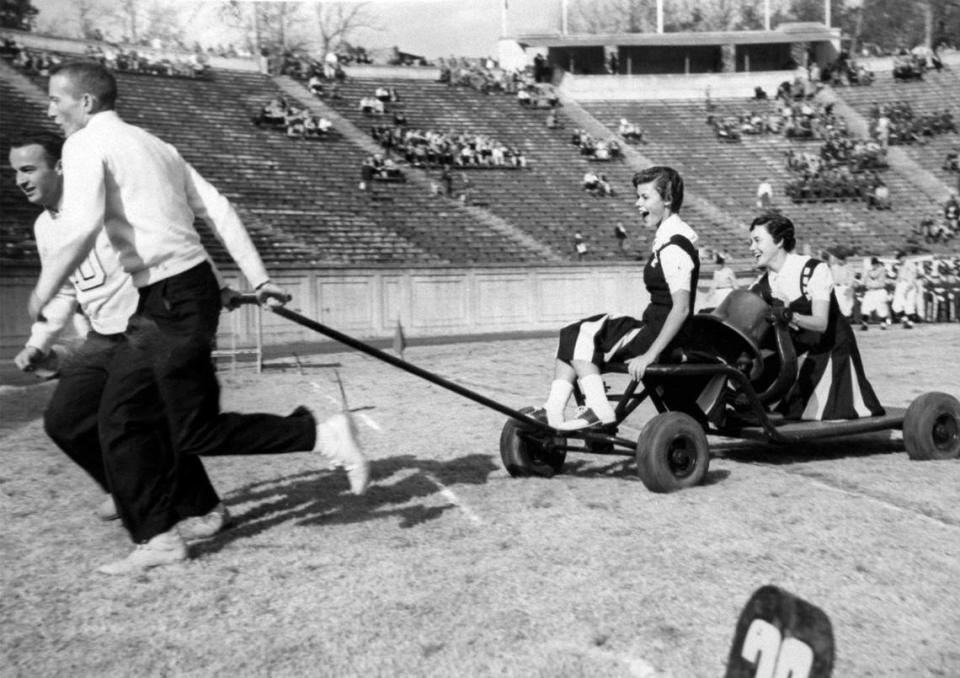
“With tongue in cheek, we offer the startling information that there’s a football game this afternoon in a West Durham pasture,” went the first sentence of Anthony J. McKevlin’s story beneath that headline, and he noted that “several million words have been written about this game … and there’ll be hundreds of thousands more written this evening.”
“The only words which count are those written this evening, for then the writing boys really will know which is the better team” between the Tar Heels and Blue Devils. With a crowd of more than 50,000 expected in Durham, McKevlin offered readers advice, too; an early form of public service journalism:
“It might be wise to leave your bottle at home, or at least to keep it under cover. The word from Durham is that drinking in public will find the drinkers running into trouble with John Law.”
If McKevlin’s prose — “writing boys;” “trouble with John Law” — sounds antiquated or like something out of a drama set in the 1930s, one that might include scenes of bootlegging or Tommy Gun-toting gangsters, well, there’s good reason for that. His story was published on Nov. 18, 1939. The day of Duke and UNC meeting as top 25 teams (top 20, in those days) for the first time.
Indeed, a crowd of 50,800, then largest ever for a college football game in the South, gathered inside Duke Stadium — before it was named after its then-head coach — to see “Wallace Wade’s boys overpower the Tar Heels” in Duke’s 13-3 victory, as McKevlin described it. Out of town journalists marveled at the atmosphere, for better or worse.

One, from Richmond, described it as “stark raving mad,” writing that “it’s impossible for staid Virginians to understand the frenzy of these Tar Heels,” and that this particular game between UNC and Duke was “Austerlitz, Waterloo and Armageddon rolled into one.” Anyone around that day might’ve thought that what they were witnessing would become the norm.
The enormous, fervent crowd. Two ranked, nationally-relevant teams.
North Carolina was at the epicenter of the college football world, and figured to stay there.
But now, nearly 84 years have passed. The first meeting between Duke and UNC as ranked football teams did not turn out to be the beginning of a long streak of similar games. It turned out to be one of a kind.
All these years later, and it still has never happened again.
Duke, UNC almost did it again
It looked, for a little while, at least, like it might happen again this season. Like the Tar Heels and Blue Devils, with championship-caliber teams in so many other sports, might finally meet again on a football field with a little number beside their names, denoting a national ranking.
College football polls don’t carry as much significance as they did decades ago (or even a decade ago), given the arrival of the College Football Playoff and the rankings its committee uses to determine the participants. The AP poll, especially, is something of a relic of a bygone time, when newspaper sports writers influenced the national discourse much more than they do now.
Yet top 25 polls aren’t completely irrelevant. They still generate conversation. They still provide a barometer of where programs stand. And, throughout much of the first half of this season, it seemed like Duke and UNC would both be ranked for their game Saturday, which would’ve been a first since the formation of the ACC in 1953.
UNC on Oct. 15 ascended to No. 10 in the AP top 25, after the Tar Heels started the season 6-0. The same week, Duke was ranked 16th nationally, after a 5-1 start and a convincing 24-3 victory against N.C. State. Certainly, the thought went then, the Tar Heels and Blue Devils could hold on for another few weeks. Certainly, they’d both be ranked for their game this season, for the first time in 84 years.
And then, well ...
And then the sort of things that have befallen both teams for a long time began happening. Again. Bad losses, in the case of UNC. Injuries, in the case of Duke. Bad luck and tough luck and no luck at all. And here we are, not even a month later, with the Tar Heels barely back in the top 25 after a pair of defeats as a double-digit favorite, and Duke completely out of it after losing its quarterback, Riley Leonard, to persistent injuries.
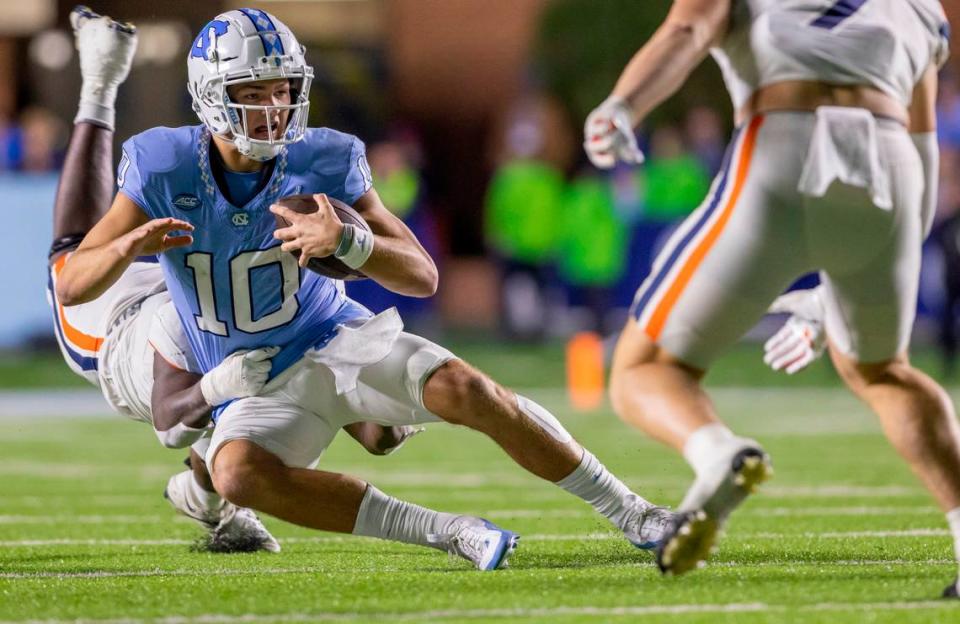
The shine that surrounded both teams is gone. The national publicity, gone. The goal of appearing in the ACC championship game, which for both appeared so realistic not that long ago – pretty much gone, barring an unlikely and incredible turn of events that’d require several layers of tie-breaking luck and complicated math. And it all turned so quickly, with Duke and UNC going from where they were to where they are.
Back to a place of hoping to overcome and climb. And now, in a new era, facing a new urgency.
In men’s basketball, both schools’ success needs little explanation or description. They’ve combined for 11 NCAA championships and are two of the most dominant programs in the history of the sport. And, for years, ACC men’s basketball was enough of a revenue-generator, of its own, to drive athletic department budgets. In a football-first world, though, that has ceased being the case. Basketball success, alone, is no longer enough, in a major college sports economy defined by football.
Duke evolves in a football world
Nina King, the Duke athletics director, does not hide from that reality, nor does she feel a need to sugarcoat it. She understands the precarious position in which Duke finds itself in a rapidly-shifting college athletics world, one predicated more than ever on football success, “brand” size in that particular sport and attractiveness to television networks, which are at the heart of all the movement.
For a long time, despite its relative lack of success in football, Duke has maintained one of the nation’s best athletics departments. Its men’s basketball team is arguably the most lucrative national brand in that sport. Its Olympic sports teams often compete for conference and national championships. The university’s standing in football, though, is why King felt like an outsider last May, during the ACC’s annual spring meetings.
Not long after the meetings began, on a Monday afternoon, King found herself in a conference room with the ACC’s other athletics directors. Soon the room began to buzz, King and her colleagues pulling out their phones to read a report, from national college football reporter Brett McMurphy, that officials from seven ACC schools had been regularly convening to explore whether they could escape the league’s grant of media rights agreement.
“The Magnificent Seven,” as McMurphy called those schools. It was all news to King.
At the time, she said during a recent interview, it felt “so real and raw” that about half of the conference’s membership had been meeting privately to discuss a potential split. Her level of concern has not decreased in the past six months.
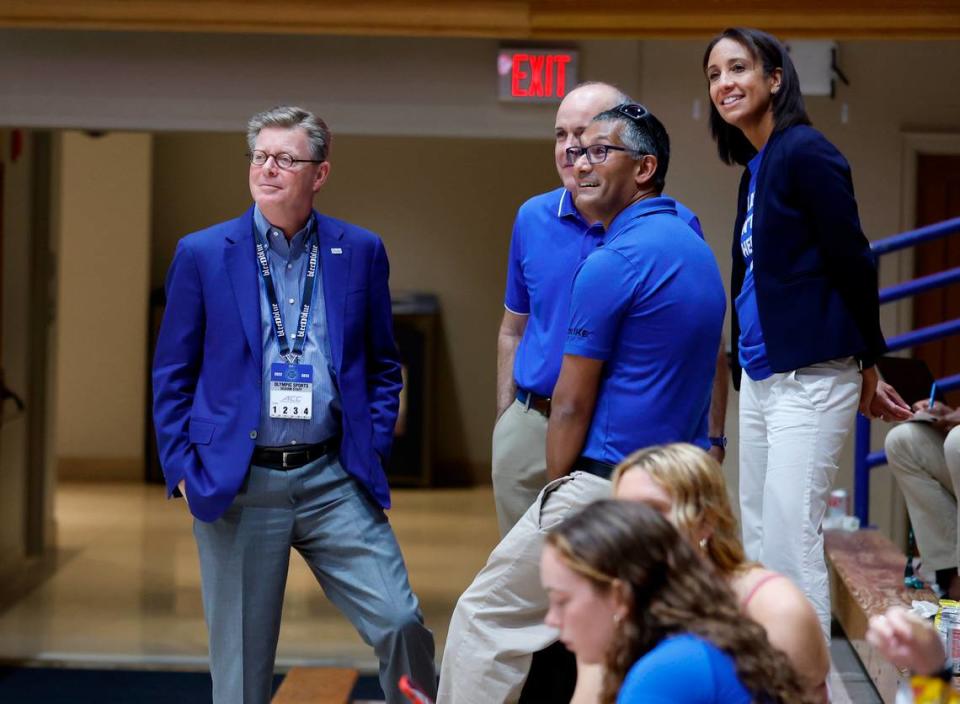
“Duke wasn’t in that conversation,” she said earlier this month. “And so that is what I don’t want to happen, when any rounds of realignment are happening, whether it’s schools coming into our conference, going out, whatever it might be, I don’t want to be left out of the conversation.
“And so to stay relevant and make sure that we are on the radar when the landscape is shifting, it’s going to take football being a consistently good program. So that’s why we are talking about that. We’re not shy about it, when we talk to donors, when we talk to Duke community supporters.
“It’s a priority for us to make sure football is good, and not at the expense of any other sport.”
King, 45, became Duke’s athletics director in 2021, after 13 years in other roles in the department. She earned her undergraduate degree in accountancy from Notre Dame in 2000, and later worked in the athletic department there before starting at Duke in 2008. Upon her arrival, she knew what a big-time college football program looked like — and she knew she didn’t see one at Duke.
The program’s abysmal record back then — with one winning season and 10 with two or fewer wins between 1990 and 2008 — spoke for itself, for one thing. But so did the condition of Wallace Wade Stadium; the fact that a track still circled the field, and that the press box doubled as a waiting room for a doctor’s office. Or, was it that the waiting room for a doctor’s office doubled as a press box?
Either way it was “shocking,” King said, when she learned that the Duke Sports Medicine building was used in such a way. Early in her time at Duke, she said, her mom broke her ankle. One of her appointments was in the doctor’s office-slash-football press box that overlooked the stadium.
“We had to hire a company to come in and move the furniture around on home football Fridays, and put it back together on Sunday to be a doctor’s office on Monday,” King said. “Oh, my gosh. So that was easy to sell to people – ‘Hey, listen, this is not Division I football.
“‘I mean, we can’t be operating like this.’”
The past decade has brought considerable improvement to Duke’s football facilities. The track that once surrounded the field at Wallace Wade was removed in time for the 2015 season, with the field lowered and the stands moved closer. In 2016, a five-story, 90,000-square foot building opened, containing a press box and luxury suites and other amenities that’d long become common around the country.
And little by little, Duke proved its competitive mettle on the field. David Cutcliffe proved winning was possible at Duke during a 14-year tenure that included six bowl appearances and a 10-win season in 2013, when the Blue Devils won the Coastal Division and played for the league championship. When the program declined in Cutcliffe’s final three seasons, the university fired him in late 2021.
That was among the strongest signs yet that Duke was no longer content to be an afterthought in the sport; that now it took football seriously. Under Mike Elko, now in his second season, there have been flashes of what’s possible. The Blue Devils won nine games last season, and then began this one with an emphatic victory against Clemson in front of a raucous home crowd, which produced an atmosphere rarely seen at Wallace Wade.
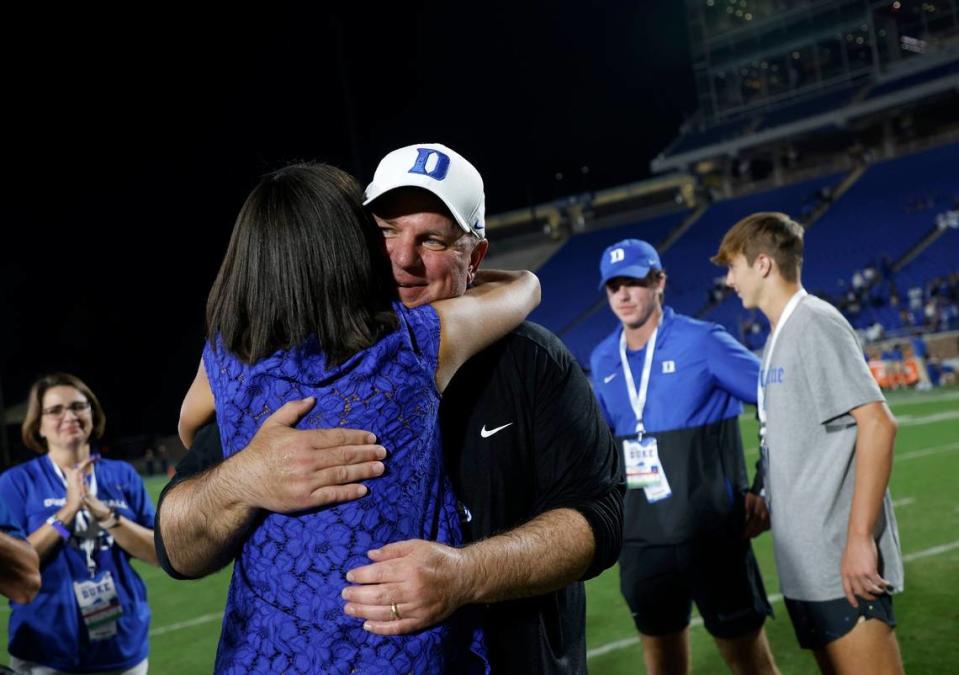
There was a similar scene for Duke’s home game against Notre Dame, albeit in a Blue Devils’ defeat. And, during Elko’s weekly radio show at the Washington Duke Inn, across the street from campus, empty seats have been more difficult to come by. The same could be said at Wallace Wade, though Duke’s home victory against Wake Forest, played in front of a half-full stadium on a chilly early November night, offered a reminder that progression toward the desired culture can be slow.
Still, it’s better than it used to be.
“I can remember coming to games with one of my little girls, and my friend’s little girls, and we’d sit in the section over there kind of where the students sit now – we’d be the only ones,” David Casey, a longtime Duke fan, said before one of Elko’s recent radio shows. Casey has been coming to Duke football games since the 1970s, he said. “There was no winning of football games back then.”
“Except for those years with (Steve) Spurrier and (Fred) Goldsmith,” said Casey’s friend, Grover Blackburn. “It was always the expectation that Duke, well, it’s a private school. (Good) academics. The expectations were not high.”
In less than two full seasons, Elko has changed the expectations, and the hope. And, nights at Wallace Wade like the ones when Clemson and Notre Dame were in town have provided an indication of what’s possible (just as the atmosphere against Wake Forest showed, again, how much work there is to be done). Soon enough, it’s likely King and Duke’s administration will be confronted with another football challenge: Can they keep Elko?
Undoubtedly, he’s likely to be a target of schools with openings — schools that could offer more football tradition or fan support or, perhaps, a place in a more secure conference, whether that’s the Big Ten or the SEC. King laughed at the question of whether Duke can keep Elko, though not in a dismissive way. It was in a way that suggested she knows it’s a question she’ll continue to have to address, and she didn’t necessarily view that as a bad thing.
“We have a great relationship and open communication,” she said. “And we talk about those things. And, you know, it’s about me understanding what he needs to be successful here. And for me to ensure that he and his family want to stay here for a long, long time. So yeah, I mean, of course, you worry when you see his name in the paper and people talking about him.
“But it’s a good thing. Him being successful is a great thing for us.”
UNC haunted by ‘what-ifs’
Among all the what-ifs in UNC’s mostly-cursed football history (what if the Tar Heels, as heavy favorites in recent weeks, just could’ve beaten Virginia and Georgia Tech joins the pantheon), the greatest is likely this: What if Mack Brown hadn’t left at the end of the 1997 season?
UNC has flirted with prolonged national relevancy over the years, from its success in the leather-helmeted years of the 1930s and 40s to the run of strong teams in the early-1980s under Dick Crum to the ascent of the mid-90s under Brown during his first tenure in Chapel Hill.
And then, just when Brown had turned the Tar Heels into a top-five team, a worthy contender in both the ACC and nationally, he left to become the head coach at Texas. What if he hadn’t?
For years — since Brown’s departure, really, given a long streak of head coaching hires that haven’t worked out, for one reason or another — the question has haunted UNC. The Tar Heels have been close, at times, to breaking through. And then have suffered various calamities.
Butch Davis, for instance, amassed a level of talent in the late-2000s not seen at UNC since Brown’s best teams. And then Davis’ program fell apart amid the beginning of an NCAA investigation that began in 2010, and led to his firing just before the 2011 season. Larry Fedora guided the Tar Heels to an 11-win season in 2015, and the ACC championship game. And then UNC won 13 games his next three seasons — five, in his final two — and he, too, was fired in 2018.
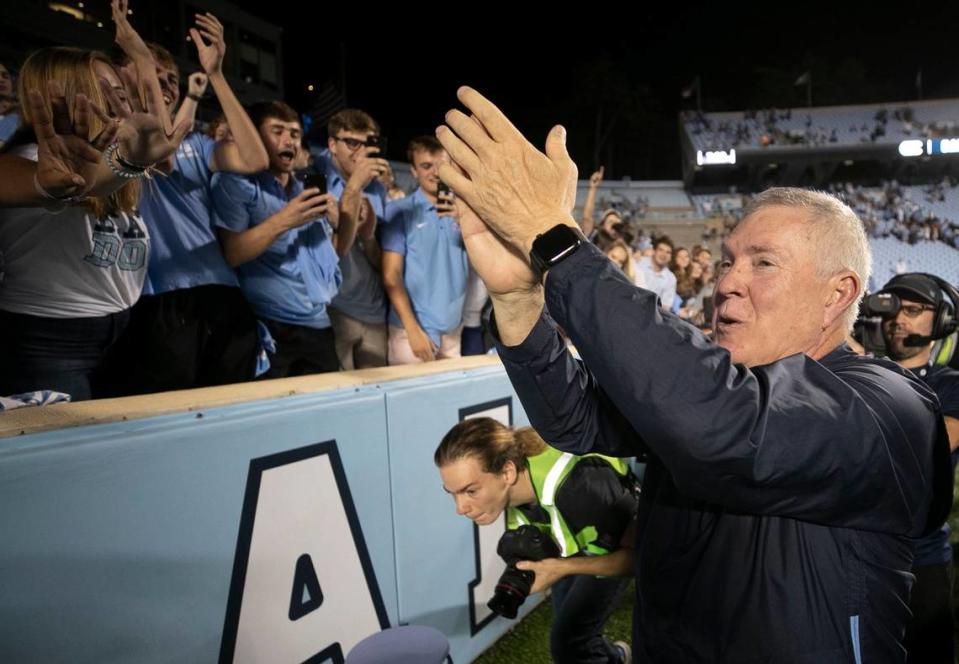
Brown’s return after that season elicited an outpouring of nostalgia among UNC supporters, and hope that he could lead the Tar Heels back to where he’d led them in the 1990s. His return also begged the question of what might’ve been possible had he never left in the first place.
“I didn’t want to leave,” Brown said during a recent interview, prefacing that with, “I don’t want to get back into the whole story.”
But, he said, “Texas offered me a better contract. They offered me more years. And I just felt like at that time, they wanted me more than North Carolina. And I thought that was the best thing to do in my career.”
A perception has emerged that part of why Brown left in 1997 — that part of UNC’s problem in football, for decades — has been a lack of institutional commitment. It can be difficult quantity in mere financial terms, and both Brown and Bubba Cunningham, UNC’s athletics director, refuted the notion that the university hasn’t supported football to the degree it needs to be successful.
“We’ve always felt like we’ve been all in on football,” Cunningham said. “You know, we’ve tried to support all of our programs to be top three, top 10 (nationally). Football’s just bigger, and there’s so many moving parts to it. We’ve got 85 scholarships, you’ve got 50 some-odd people in the building.
“It just, it’s hard to move it and you have to win a lot on a consistent basis, to have a reputation of really being a great football program. And I feel like we’re knocking on the door. We’ve been knocking on the door for a while. I think Larry got us there for a bit. And then we stumbled.
“Mack has gotten us more consistently there.”
A pattern has emerged during Brown’s second tenure at UNC, though, of progressing to a point only to stumble, without ever achieving the ultimate goal of winning the ACC or breaking through, nationally. The latest example came with the consecutive defeats after the Tar Heels entered the top 10 last month. A season ago, UNC climbed to as high as No. 13 before ending the season with four consecutive losses.
In 2021, it began 10th nationally but was unranked by the end of September. In 2020, playing through the strangeness of mostly empty stadiums and regular schedule disruptions amid the pandemic, UNC ascended to No. 5 nationally before losing at Florida State. The Tar Heels earned a bid to the Orange Bowl, in which they suffered a defeat against Texas A&M, but never again became a top-10 team that season. Time after time since his return to Chapel Hill, Brown has led UNC to a moment of breakthrough without ever actually achieving it.
And now college athletics continues to change. UNC’s place at the table of major college sports is secure, thanks to its overall stature and desirability. It hasn’t faced the same existential crisis as, say, Duke. If the ACC crumbled, like the Pac-12, there’s little doubt UNC would be a welcome addition for either the Big Ten or the SEC. What concerns Cunningham, though, is the potential for massive disruption to college athletics’ economic model.
The so-called arms race in college football, alone, has reached a point of absurdity that was difficult to anticipate 20 or even 10 years ago, with coaching salaries and other costs (including buyouts) continuing to stretch budgets. UNC, meanwhile, prides itself on the depth of its offerings, with 28 varsity sports and more than 800 athletes. Football is the economic engine, as it is everywhere now, but how to invest in it, while taking care of everything else, is becoming more of a question.
“How much is enough becomes a question,” Cunningham said. “But the concern that I have right now, looking over the next three to five years, is what does the economic model look like?” and then he listed the numerous legal cases the NCAA is battling, ones that could — and perhaps are even likely to — leave college sports with more of a direct employer-employee relationship with athletes.
“All of those concern me about our future,” Cunningham said. “And what does that economic model look like? How do we sustain 28 teams, 850 student athletes, because I think those teams and those kids’ experiences are incredibly important to us. And I want to maintain them. But we do have to find that (balance). So that becomes the issue that we’re all trying to wrestle with.”
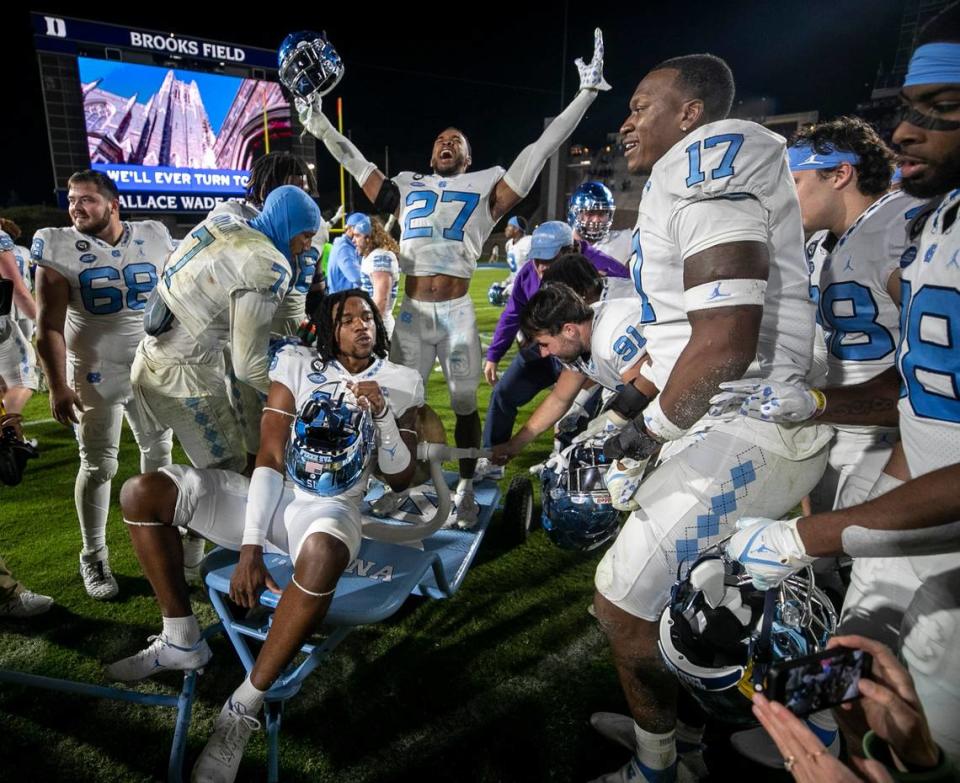
During an interview last month, before his team’s defeats against Virginia and Georgia Tech, Brown defended UNC’s commitment to football, and made the point that the university’s administration has “tried to step up and do everything that we need.”
“And not much had been done, since I left, on the facility,” he said. “So a lot of the boosters that helped before stepped back up.”
There were signs of the progress, at least in terms of renovations and facilities. UNC’s indoor football practice facility, which was in the works during Fedora’s final seasons, opened in 2019. In recent years, the university has remodeled the locker room and the weight room and redone much of the interior of the Kenan Football Center. More renovations are to come, too.
The change Brown and others most want to see, though, hasn’t yet materialized. Not fully.
“We’ve had good years,” he said. “We just haven’t been great. And that’s what we want to do. We want to go from being a good program to a great program and, and be consistently great, and be considered a great program every year.
“Like we were in the late 90s, that when people started talking about football, North Carolina was in the conversation.”
The wait continues
There was an extended moment when the national college football conversation regularly included both Duke and North Carolina, though it was a long time ago. The schools both flirted with national power status through the 1940s and, for Duke, into the 1950s. But then, very rarely after that. And yet even in the 40s and 50s, they never met as ranked teams.
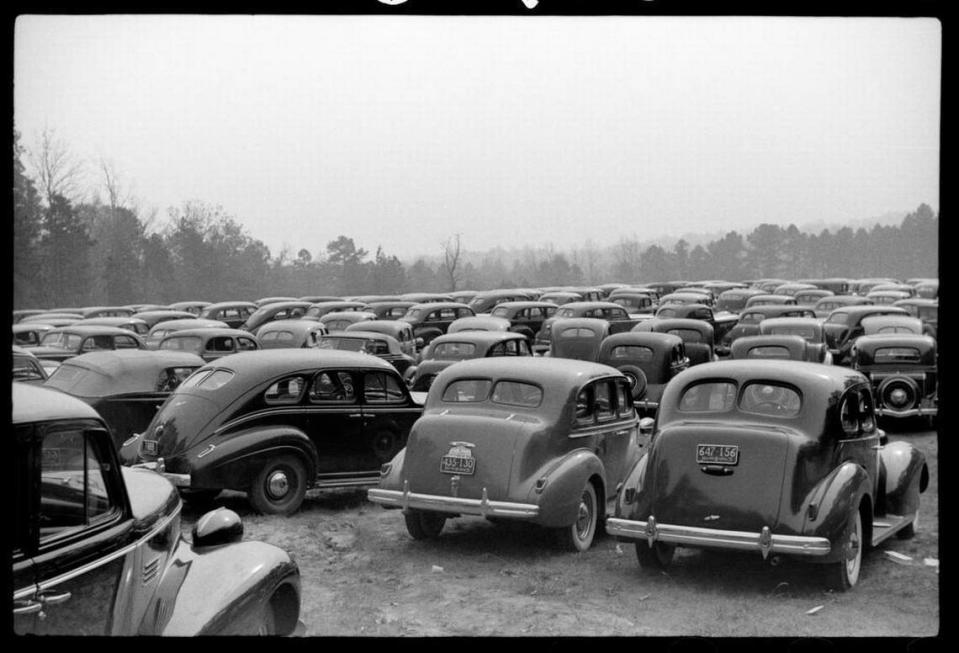
No, that happened only once. The game in Durham in 1939 was a memorable enough cultural event that Marion Post-Wolcott photographed it, and the scene it invited, for the Farm Security Administration, which was part of The New Deal’s Works Project Administration. Post-Wolcott earned acclaim for her photography of life in the South, and the moments she captured on Nov. 18, 1939, speak to the intense environment at Duke when the ranked Tar Heels came to town.
There are endless rows of 1930s cars parked all over the campus grounds. The stands at Duke Stadium are completely filled, with spectators standing and hanging over railings. People are lined up at a concession stand covered in cigarette ads for Chesterfields and Phillip Morris. There’s a young woman standing beneath a sign prohibiting drinking and, in another photograph, a group of suit-wearing men standing outside the stadium, holding what appear to be bottles of liquor.
Indeed, “the man without a bottle here yesterday was a rare bird,” wrote Chauncey Durden in the Nov. 19, 1939 edition of the Richmond Times-Dispatch.
Though not, as it turned out, as rare of a football game between top 20 teams at Duke and Carolina. Eighty-four years, and the wait continues for another one.
